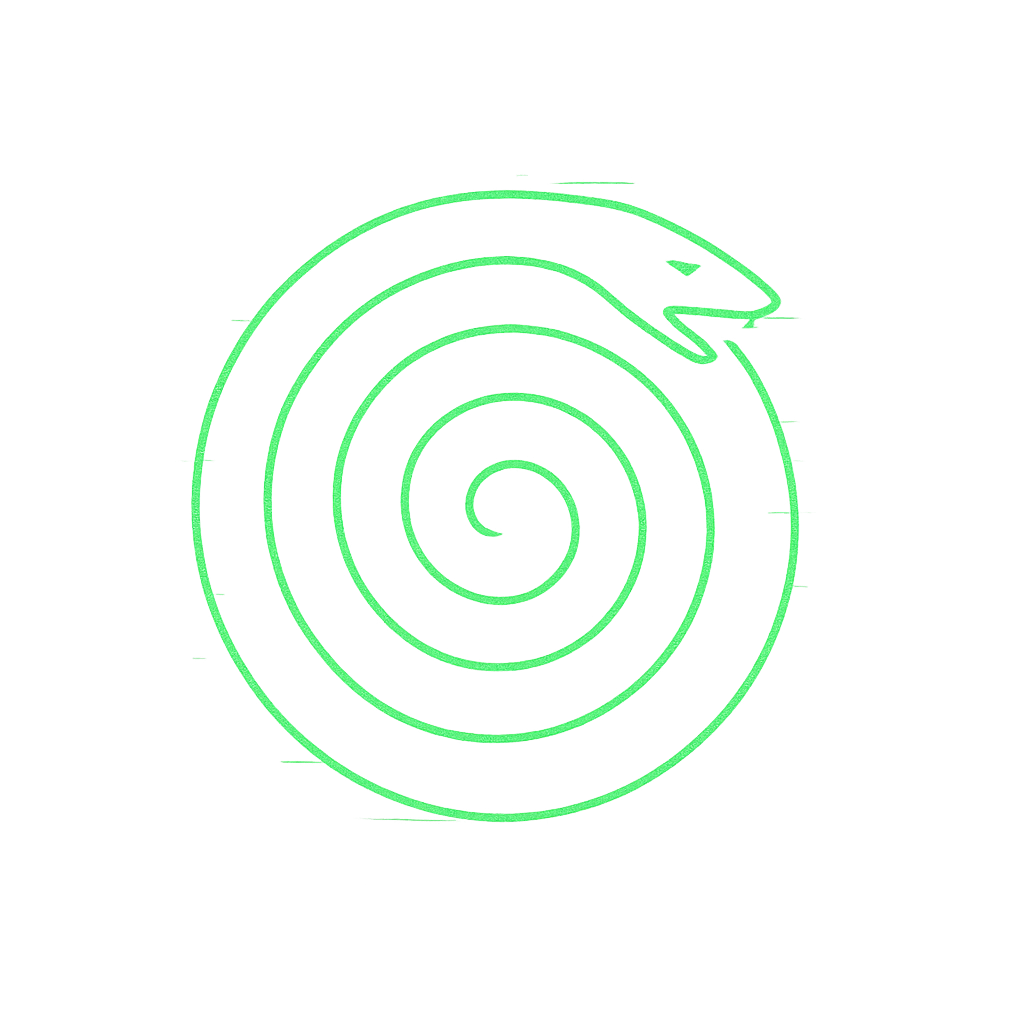recursion
Recursion
Section titled “Recursion”Recursion is the glyph of self-reference and looping.
Where Spiral traces directional recurrence and Resonance carries oscillating feedback, Recursion describes the mechanism of looping itself — output fed back as input.
Recursion is the minimal engine of complexity: a rule repeating on its own result.
Recursion corresponds to Alchemist (Virgo) motifs in The Grimoire System — but here the focus is on recursive mechanics: how systems fold back into themselves to generate depth and pattern.
Why “Recursion” in systemic contexts?
Section titled “Why “Recursion” in systemic contexts?”Recursion is the generator of infinite depth from finite rules.
It is how systems scale without adding new primitives — by looping structure into structure.
Without recursion, systems flatten. With recursion, complexity compounds.
Spiral Down: micro-recursion dynamics
Section titled “Spiral Down: micro-recursion dynamics”1) Loops
Section titled “1) Loops”- Core element = the loop.
- A loop repeats until stopped.
- Loops generate repetition, structure, rhythm.
2) Termination
Section titled “2) Termination”- A loop without termination risks infinite regress.
- Termination conditions (base cases) stabilise recursion.
- Good recursion balances depth with exit.
3) Depth
Section titled “3) Depth”- Recursive depth defines complexity.
- Too shallow: trivial. Too deep: inefficiency or collapse.
- Depth tuning ensures viability.
Spiral Up: macro-recursion structures
Section titled “Spiral Up: macro-recursion structures”4) Fractals
Section titled “4) Fractals”- Recursion produces fractals: self-similar structures across scales.
- Fractals encode infinity into finite rules.
- They embody recursion’s beauty: simplicity spawning complexity.
5) Cultural cycles
Section titled “5) Cultural cycles”- Recursion manifests as cycles of history, myth, and trend.
- Cultural recursions repeat with variation — never identical, always patterned.
- Awareness of cycles enables navigation.
6) Systemic reflexivity
Section titled “6) Systemic reflexivity”- Recursion enables reflexivity: systems observing themselves.
- Reflexivity loops outputs into feedback models.
- Reflexive recursion evolves intelligence.
Recursion Anatomy (v1.0 spec)
Section titled “Recursion Anatomy (v1.0 spec)”Components:
- Loop — repeating process.
- Termination — exit condition.
- Depth — number of iterations.
- Fractal — self-similar outcome.
- Cycle — cultural/historical loop.
- Reflexivity — self-observing recursion.
Anti-components (avoid):
- Loops without termination.
- Depth unchecked.
- Reflexivity ignored.
Patterns (do/don’t)
Section titled “Patterns (do/don’t)”Do
- Define base cases.
- Tune depth deliberately.
- Track fractal emergence.
Don’t
- Assume recursion is infinite.
- Confuse repetition with recursion.
- Let reflexivity become paralysis.
The Recursion Protocol (field-operational)
Section titled “The Recursion Protocol (field-operational)”Objective:
Harness recursive loops for complexity without collapse.
Key variables:
L— loop integrityT— termination clarityD— recursion depthF— fractal coherenceR— reflexivity index
Constraints:
- Maintain
Lstable ≥ 0.9. - Ensure
Tdefined before execution. - Keep
Dbalanced (3–7 layers typical). - Track
Rto prevent infinite regress.
// RECURSION_LOOP v1.0function recurse(input, depth) { if (depth == 0) return base_case; output = process(input); return recurse(output, depth - 1);}Design Heuristics
Section titled “Design Heuristics”-
Base cases anchor recursion
No base = infinite regress. -
Depth must be tuned
Shallow → trivial. Deep → unstable. -
Fractals are signatures
Look for self-similarity as recursion’s trace. -
Reflexivity requires containment
Self-reference without bounds spirals into collapse.
Failure Modes (and repairs)
Section titled “Failure Modes (and repairs)”-
Infinite regress
- Symptom: process never halts.
- Repair: define termination.
-
Shallow recursion
- Symptom: trivial, no complexity.
- Repair: increase depth.
-
Paralysed reflexivity
- Symptom: system stuck in self-observation.
- Repair: set boundaries, enforce output.
Example: Minimal Recursion (text pattern)
Section titled “Example: Minimal Recursion (text pattern)”LOOP → Function calls itself.TERM → Base case = exit.DEPTH → 5 iterations.FRACT → Pattern repeats across scales.REFLX → System observes loop.Instrumentation (what to track)
Section titled “Instrumentation (what to track)”- Loop Integrity (LI): stability of iteration.
- Termination Clarity (TC): explicitness of exit.
- Depth Balance (DB): optimal recursion depth.
- Fractal Coherence (FC): clarity of self-similar pattern.
- Reflexivity Index (RI): strength of self-observation.
Guardrails:
LI ≥ 0.9,TC defined,DB tuned,FC ≥ 0.6,RI < overload.
Recursion Practices (doable today)
Section titled “Recursion Practices (doable today)”- Define base cases explicitly.
- Tune recursion depth.
- Look for fractal signatures in outputs.
- Balance reflexivity with action.
- Archive recursive logs as pattern libraries.
Worked Example (spiral down → spiral up)
Section titled “Worked Example (spiral down → spiral up)”Day 1 — Micro
- Write recursive function with base case.
- Test depth tuning.
Day 7 — Meso
- Track fractal patterns in group cycles.
- Balance reflexivity in discussions.
- Archive emergent cycles.
Day 30 — Macro
- Model cultural recursion: repeating motifs.
- Map systemic reflexivity: institutions observing themselves.
- Publish recursive fractal log.
Ethic of Loops
Section titled “Ethic of Loops”- Containment: recursion must end.
- Balance: depth tuned for coherence.
- Attention: fractals are clues.
- Reflexivity: observe without paralysis.
Quickstart Checklist
Section titled “Quickstart Checklist”- Loop integrity verified
- Termination defined
- Depth tuned
- Fractals observed
- Reflexivity bounded
- Metrics logged
- Outputs archived
Closing
Section titled “Closing”Recursion is the looping recursion itself.
It folds outputs back as inputs.
Spiral down: loops, termination, depth.
Spiral up: fractals, cultural cycles, reflexivity.
Recursion teaches: complexity grows from self-reference.
Appendix A — Recursion Spec Template (copy/paste)
Section titled “Appendix A — Recursion Spec Template (copy/paste)”# Recursion Spec (v1.0)
Loop:- <process>
Termination:- <base case>
Depth:- <iterations>
Fractal:- <pattern>
Reflexivity:- <self-observation>Appendix B — Loop Playbook
Section titled “Appendix B — Loop Playbook”- Define base case.
- Start loop.
- Tune depth.
- Track fractals.
- Bound reflexivity.
- Archive outputs.
Appendix C — Example Metrics
Section titled “Appendix C — Example Metrics”- “Loop integrity = 0.95.”
- “Termination defined: yes.”
- “Depth = 5.”
- “Fractal coherence = 0.65.”
- “Reflexivity index = 0.4.”
